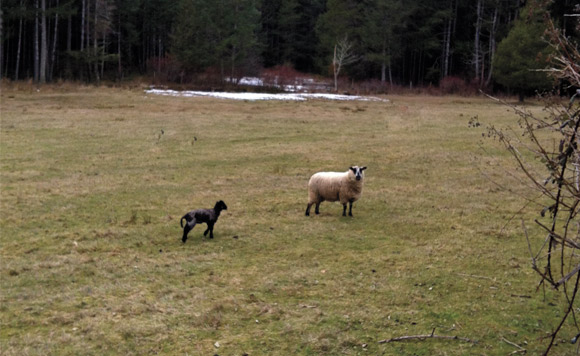by Trysh Ashby-Rolls –
Lambs and their mothers dot the landscape across the Gulf Islands. Lambing is in full swing.
Alongside the driveway up to the warm sheep shed where Jodi Schamberger bottle-feeds day-old twins, older lambs curl into their mothers’ wooly backs in fields of scrubby grass. Two grey lambs with black faces, exhausted from a play-fight, fold together like a ball of yarn to nap. Jodi’s own flock of 18, including a ram, is care-taking this flock of 22 while the farmer is away. The lambs suck vigorously until their individual bottles are empty. Following their birth the lambs did not suck well and were fed every couple of hours including through the night. “It’s hard, but you do it. It’s part of the job.”
The bottles contain colostrum, precursor to mother’s milk, high in the nutrients lambs must have if they are to survive. If they don’t get the colostrum in the first six hours of life when they best absorb it, “then they’re pretty much toast.” Jodi has to make up a batch of artificial colostrum from a package. The mother has a condition called mastitis and is unable to feed her babies herself.
Barbara Grimmer is B.C. Director for the Canadian Sheep Federation, with a PhD in Nutritional Biochemistry. “Mastitis is an inflammation of the udder,” she explains. “The udder gets hot and red.”
“It’s a good sign the lambs have made it through 24 hours,” says Jodi Schamberger. Soon she’ll switch them onto specially formulated sheep milk powder. “They’ll be on that for three months.”
Every flock on small sheep farms has its resident ram, kept busy once the days start growing shorter and ewes come into oestrus. “Before they’re bred, females are given what’s called a grain ‘flushing’ that’s high in protein,” Jodi says. “You want twins.” This is the second year one of her own ewes has had healthy triplets.
Every day, she walks both her own and the farm she’s looking after, looking for ewes either in labour or going into labour. “I know all my sheep by name. In labour, either they don’t come in for feeding or they stand off a bit from the group. Their behaviour changes.”
Dr. Grimmer says the ewe’s voice changes. “It’s the same special voice she uses to talk to her lambs.” She observes that when the ewe starts labour, she’ll go into a corner, paw the ground with her front legs as if making a nest, get comfortable and settle in.
At the farm Jodi Schamberger is care-taking, she’s noticed ewes in labour will stay among the trees. “The lambs usually arrive quickly. The ewe cleans them off before they stand up to nurse.” Jodi daubs iodine on the umbilical stub, picks up the babies and the ewe follows her into the shed.
“The mother pants a lot but she’s quiet when she delivers,” Barbara Grimmer says. “She doesn’t want to alert her enemies.” Ravens mainly, and eagles when they return to the islands.
Despite the odds, most lambs survive and thrive. As if to illustrate the point, two males, tiny horns protruding, chase and tumble in boisterous play on the driveway leading back to the road. Suddenly spotting their mother, they charge at her for a snack.




